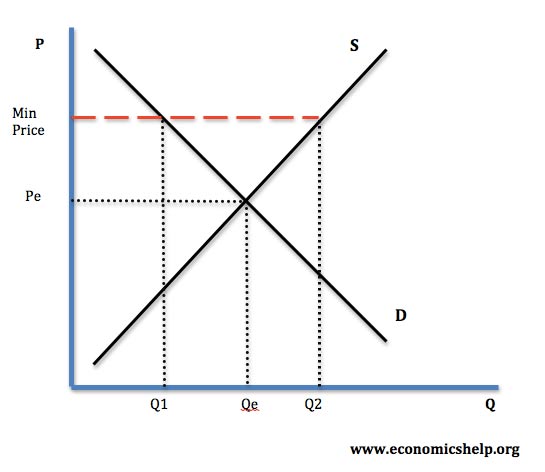Price controls – advantages and disadvantages
Summary
Price controls can take the form of maximum and minimum prices. They are a way to regulate prices and set either above or below the market equilibrium:
- Maximum prices can reduce the price of food to make it more affordable, but the drawback is a maximum price may lead to lower supply and a shortage.
- Minimum prices can increase the price producers receive. They have been used in agriculture to increase farmers income. However, minimum prices lead to over-supply and mean the government have to buy surplus.
Maximum prices
A maximum price means firms are not allowed to set prices above a certain level. The aim is to reduce prices below the market equilibrium price. The advantage is that it may lead to lower prices for consumers.

The equilibrium price is Pe. A maximum price leads to demand of Q2, but a fall in supply to Q1.
The disadvantage is that it will lead to lower supply. There will also be a shortage, and demand will exceed supply; this leads to waiting lists and the emergence of black markets as people try to overcome the shortage of the good and pay well above market price.
Examples
- Food. During the second world war, the price of goods was fixed and goods rationed. However, this encouraged people to sell on the black market through inflated prices.
- Football games. Tickets for football games and concerts are often set at a maximum price. (e.g. if left to the market, equilibrium prices would be much higher). e.g. at current prices, F.A. Cup final could sell many more tickets than 80,000. The advantage of setting this maximum prices is that it keeps football affordable for the average football supporter. It is argued that if prices were set solely by market forces, it would be just the wealthy who could afford to go to games. The disadvantage is that it means some who want to go to the game can’t because there is a shortage of tickets.
- Housing. The government may set a maximum price for renting to keep housing affordable.
- This may reduce the supply of housing leading to homelessness.
- However, it may be that landlords have monopoly power and supply is very inelastic. In this case, a maximum price may make renting cheaper without reducing supply
Minimum Prices
Minimum prices are used to give producers a higher income. For example, they are used to increase the income of farmers producing food.
The EU had a Common Agricultural Policy (CAP) which aimed to increase the income of farmers by setting minimum prices.
Diagram Minimum Prices

The equilibrium price is Pe. A minimum price leads to increase in supply to Q2, but fall in demand to Q1.
The Disadvantage of Minimum Prices
- Higher prices for consumers. We had to pay more for food.
- Higher tariffs necessary on imports. To keep minimum prices, the EU also had to put tariffs on food to keep prices artificially high.
- Minimum prices encourage oversupply and are inefficient. The CAP encouraged farmers to produce food that no one actually wanted to eat. This included using more chemicals to increase yields
- We had over-supply of food no-one wanted to eat. The EU spent up to 70% of its budget on buying surplus food. (butter mountains, wine lakes)
Conclusion
Generally price controls distort the working of the market and lead to over supply or shortage. They can exacerbate problems rather than solve them. Nevertheless, there may be occasions when price controls can help for example, with highly volatile agricultural prices.
- A better solution to maximum prices may be to increase the supply of housing.
- A better solution to minimum prices may be to offer subsidies to farmers who promote some environmental benefit to society – rather than through prices.
